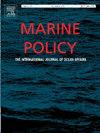将远洋生境状况的变化与对人类福祉的影响联系起来的评估模型
IF 3.7
2区 社会学
Q2 ENVIRONMENTAL STUDIES
引用次数: 0
摘要
浮游生物监测数据集有助于根据欧洲联盟海洋战略框架指令和联合王国海洋战略评估海洋生物多样性指标。这些指标用于评估东北大西洋远洋生境状况的长期变化,然后指导政策的制定和执行,以实现良好的环境状况。在所有生态系统中,环境变化有可能通过改变生态系统服务的数量和质量来影响人类福祉。在这里,我们开发了一个社会生态评估模型,可以描述浮游生物指标证明的远洋栖息地状态的变化如何影响人类福祉。我们表明,通过改变“商品和利益”的可用性(通过生态系统服务提供),例如浮游植物对气候调节的贡献,以及通过调节“生态系统危害”的风险,远洋栖息地状态可以影响人类福祉。重要的是,远洋生态系统状态的变化还将推动更广泛的海洋食物网中生态系统服务和生态系统危害的变化,这得到与浮游生物相关的生态系统过程(如初级生产速度)的支持。将提出的评估模型应用于浮游生物监测数据,凸显了更深入了解由海洋栖息地状态变化驱动的人类福祉影响的潜力。在充分利用现有浮游生物监测数据的同时,量化远洋生境状态变化对人类福祉的影响,为决策者增加了证据基础。本文章由计算机程序翻译,如有差异,请以英文原文为准。
An assessment model for linking changes in pelagic habitat state to impacts on human wellbeing
Plankton monitoring datasets help inform indicators for marine biodiversity assessments under the European Union Marine Strategy Framework Directive and United Kingdom Marine Strategy. These indicators are used to assess long-term changes in the state of the pelagic habitats of the Northeast Atlantic which then guide policy formation and implementation to achieve Good Environmental Status. Across all ecosystems, environmental change has the potential to impact upon human wellbeing by changing the quantity and quality of ecosystem services. Here, we develop a socio-ecological assessment model that can describe how variations in pelagic habitat state, evidenced by plankton indicators, can impact human wellbeing. We show that pelagic habitat state can influence human wellbeing through changing the availability of ‘goods and benefits’ (as made available via ecosystem services), such as the contribution of phytoplankton to climate regulation, but also through mediating the risks of ‘ecosystem hazards’. Importantly, changes to pelagic ecosystem state will also drive changes to ecosystem services and ecosystem hazards in the wider marine food web, supported by ecosystem processes associated with plankton, such as the rate of primary production. Applying the proposed assessment model to plankton monitoring data highlights the potential for a greater depth of understanding of the human wellbeing impacts driven by state changes in pelagic habitats. Alongside making best use of the available plankton monitoring data, quantifying the human wellbeing impacts arising from changes to pelagic habitat state increases the evidence base for decision makers.
求助全文
通过发布文献求助,成功后即可免费获取论文全文。
去求助
来源期刊

Marine Policy
Multiple-
CiteScore
7.60
自引率
13.20%
发文量
428
期刊介绍:
Marine Policy is the leading journal of ocean policy studies. It offers researchers, analysts and policy makers a unique combination of analyses in the principal social science disciplines relevant to the formulation of marine policy. Major articles are contributed by specialists in marine affairs, including marine economists and marine resource managers, political scientists, marine scientists, international lawyers, geographers and anthropologists. Drawing on their expertise and research, the journal covers: international, regional and national marine policies; institutional arrangements for the management and regulation of marine activities, including fisheries and shipping; conflict resolution; marine pollution and environment; conservation and use of marine resources. Regular features of Marine Policy include research reports, conference reports and reports on current developments to keep readers up-to-date with the latest developments and research in ocean affairs.
 求助内容:
求助内容: 应助结果提醒方式:
应助结果提醒方式:


